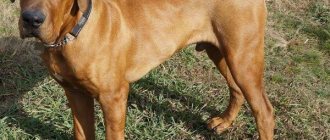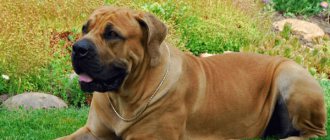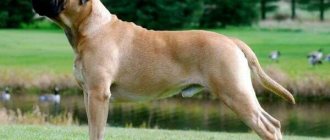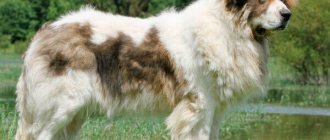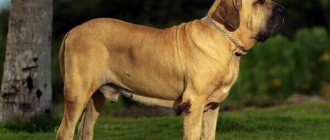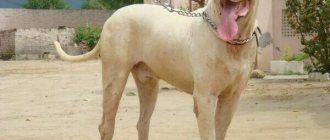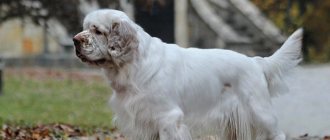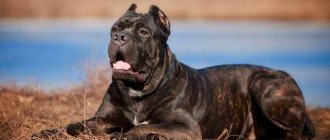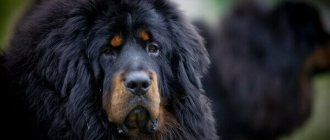- 6 Health and life expectancy
- 7 Choosing a Tosa Inu puppy 7.1 Price
Origin story
A hundred years ago, Japan was in great need of a fighting and hunting dog capable of teamwork . At that time, the Nihon Inu breed existed and was popular in this country.
They were used in hunting, but they did not obey their owner well, which was unacceptable.
At the same time, dog fighting was very popular in Japan . The Nihon Inu were much inferior to their opponents because they were much smaller and weaker. This hurt the honor of the samurai and the Japanese did not like it, because everyone wanted to win.
It was decided to create a breed through selection that would satisfy the needs of everyone. The Nihon Inu has been crossed with various Western breeds. It was a bulldog, bull terrier, mastiff, mastiff, pointer.
The result of such long work was the Tosa Inu breed, or Japanese mastiff . This dog was hardy, large and obedient.
Many years have proven that the Japanese Mastiff is not a family dog at all, but a fighting dog. The breed is still banned in some US states.
Istrian breed
Europeans poured into Japan as soon as the policy of internal isolation ended. They traveled with their belongings - things and animals, including large purebred dogs, which amazed the short Japanese with their size, beauty and strength. As is known, the country has long been fond of dog fights, the participants of which were local Nihon Inu, which looked simply ridiculous in comparison with foreign competitors. Then breeders began to cross local dogs with those that arrived in the country.
To get this breed, they took Bull Terriers, Bulldogs and Nihons, and also used the blood of Mastiffs, Pointers, Great Danes, and St. Bernards. It is clear that the new breed could not possibly be a decorative dog, following its owner everywhere. They saw her on the Japanese island of Shikoka in one of the provinces called Tosa (hence the name of the breed). With such fighters, the Japanese could already count on victory. The time before the war was the heyday of the breed, but the war almost completely destroyed these dogs, as well as many others. Risking their lives, the breeders saved several individuals, hiding them in a sparsely populated area of Hokkaido, transporting them to Taiwan and Korea, where the animals survived hard times.
Tosa Inu Health
The lifespan of a tosa sumatori reaches 12 years.
And this is quite good for a large Molossian type dog, which has a number of breed predispositions to diseases, inherited from a “hodgepodge” of various breeds. One of the most common problems with Tosa Mastiffs is their predisposition to various kidney diseases. These are, first of all: urolithiasis and renal failure, which often (if not treated in a timely manner) lead to the death of the animal. The second problem is heart failure, which is especially common in large-sized tosas. This problem is perfectly regulated by the use of special medications. It is important to detect the disease in time. To do this, a two-year-old dog needs to have a heart ultrasound with Dopplerography and a cardiogram.
Also, the health problems of the Japanese Mastiff include a predisposition to dysplasia of the elbow and hip joints, allergic dermatitis and follicular conjunctivitis.
Tosa is a rather complex dog in terms of health and requires constant attention.
Breed diseases
The Tosa Inu's lifespan is 8–12 years. These dogs have good immunity, so with timely vaccination they are practically not at risk of infection. But the weak point of dogs is the hip and elbow joints. If they develop incorrectly (dysplasia), the dog may become disabled. Individuals with such a defect are not allowed for breeding; the presence of this pathology in the ancestors must be noted in the pedigree. Therefore, this document must be carefully studied.
The first signs of dysplasia are lameness and limited mobility. The dog takes care of the sore paw and refuses to rely on it. Your pet can be helped with medication and surgery, but it is very important not to let the disease progress.
Puppies under one year old should not be given intense physical activity. The time for active exercises for them should be limited to 10 minutes (up to half an hour per year).
Description of the breed
- This is a powerfully built dog with well-developed muscles and high withers;
- Height does not exceed 75 cm, weight – 60-70 kg;
- The stomach is tucked, the back is straight;
- The limbs are strong, with large round pads located on them;
- The neck is large, there is a fold on it;
- The head is wide and rectangular, with a clearly defined transition from the forehead to the muzzle;
- The ears are drooping and cannot be cropped;
- The nose is black, the eyes are dark shades, expressing calm and confidence;
- The mouth is powerful and strong, well developed;
- The tail is wide at the base, narrowing towards the end. Located high.
Breed characteristics
| Short description | |
| Origin: | Japan |
| Conditions of detention: | House with garden, aviary, local area |
| Purpose: | Guard dog, fighting dog, companion dog |
| Color: | Red, brown, black, brindle |
| Wool length: | Short |
| Adult dog size: | Height – 62-82 cm, weight – 36-61 kg |
| Average life expectancy: | 10-12 years |
| Walk: | A two-time walk is required (if kept on the street, you can get by with a one-time walk, but for 2 hours) |
| Physical activity needs: | High demands for physical activity (daily training 1-2 hours, walking, games) |
| Fédération Cynologique Internationale (FIC) classification: | Group 2: Pinschers and Schnauzers, Molossians, Mountain and Swiss Cattle Dogs; section 2: Molossians |
| Puppy price: | The average price is 20,000-30,000 rubles. Without pedigree - 20,000 rubles, pet class - up to 25,000 rubles, breed class - 27,000 rubles, show class 30,000 rubles (maybe higher) |
Interesting facts about tosa sumatori
In modern Japan, just like in the old days, dog fights are held quite legally.
And it is even more surprising that they flourish in that very former Japanese province of Tosa, now part of Kochi Prefecture, where the main and only Japanese Molosser dog, Tosa Inu, comes from. It is there, in the town of Katsurahama, that the Tosa-token Center is located - a place where Toso fighting dogs are bred and trained. Dog fights, famous throughout the world for their original Japanese style, are also held there. Unlike the bloody spectacles inherent in European and American versions of dog fights (often ending in the death of one of the opponents), the Japanese style is reminiscent of sumo wrestling. The task of a fighting mastiff in the ring is not to inflict fatal bites and injuries on an opponent (dogs are specially trained for this). The dog is simply obliged to knock down the enemy and hold him in this position for some time (usually 3-5 minutes). The dog fight itself lasts from 15 minutes to half an hour. And if during this time the winner is not determined, the fight ends anyway. A dog that growls, barks, whines, turns its tail towards its opponent, or takes three steps back during an attack is automatically considered a loser. And although dogs still cannot avoid scratches and abrasions, the entire fight, accompanied by beautiful ritual ceremonies, looks not like a bloody massacre, but like a sporting competition, with a demonstration of strength and respect for the opponent, rules and traditions. The winning dog (and only males participate in the fights) receives the title “Yokasuma” (“winner of the ring”) and a hemp wreath with samurai symbols. The dog that becomes the absolute champion is awarded an honorary “apron blanket” embroidered with gold and brightly colored silk, and the title is “Yokozuna” (“great champion”).
Character traits
Only a person of strong character, and certainly not a beginner, can properly raise a dog of this breed.
Mastiffs are neither stupid nor uncontrollable . On the contrary, they are distinguished by attentiveness, balance, intelligence and calmness.
But behind this there is also a great inner strength, which only a person equally strong internally can subjugate.
Leadership qualities are important when raising and training a mastiff..
The dog has developed protective potential. She will always stand up for the owner and those people who have earned her respect. He is quite wary of strangers, although without barking or aggression.
The dog senses the mood of people, so it does not tolerate falsehood and pretense . In a relationship with a mastiff, you need to be sincere and open, show your real intentions. This is the only way you can win the dog’s favor.
Hitting a mastiff is a bad decision . He will be angry with you, he will be afraid, and this is not respect. In this case, be prepared for the fact that at the decisive moment the dog will simply turn away from you.
Mastiffs do not like unfamiliar dogs or other pets in general. They will treat them with aggression only if they did not grow up together.
The dog is difficult to train, so it should be trained from an early age.
Expert opinion
Kozhevin Semyon Kirillovich
Expert dog handler.
“This dog is clearly not for the family or for interacting with small children. Mastiffs are proud and calm, but they definitely will not tolerate disrespect, and they perceive children as puppies, that is, they can bite and growl. If you have managed to earn the favor of a mastiff, he will respect and protect you to the death. These are extremely loyal dogs that will fight for their owner to the last.”
Character and behavior
Tosa Inu are brave, patient and cold-blooded dogs bred for fighting. Despite their turbulent past, Japanese mastiffs are not prone to causeless aggression and are friendly towards all members of the owner's family.
Active and temperamental Tosa Inu, on the orders of the owner, can lie for a long time, watching what is happening from the side and without anything reminding of their presence.
Japanese mastiffs are very loyal to their owners, but due to their natural characteristics they will not miss the opportunity to take a leadership position. Therefore, they are not suitable as a first dog; they will not obey soft-tempered people who have no experience in raising serious breeds.
Japanese Mastiffs are reserved towards strangers and do not show friendliness even to those who often come to visit. The apparent relaxation of these dogs is very deceptive. They never lose their vigilance and are ready to attack the enemy at any moment. Moreover, Japanese mastiffs attack silently, without emitting a warning bark.
Breed and children
Dogs of this breed get along well with children, but they treat them not as play partners, but as objects for protection. It should be borne in mind that strong and heavy Japanese mastiffs are not ready to tolerate all childish pranks and if the owner’s heirs cross their boundaries, they can respond with aggression. Therefore, it is better not to leave dogs and children alone without the supervision of an adult.
Breed and other animals
With timely socialization, Tosa Inu are comfortable with the company of other animals, including cats and rodents. These dogs do not have hunting instincts, so they do not feel the need to chase small animals.
Who is the dog suitable for?
Tosa Inu is not a breed for beginners . Suitable for people with a strong character who are not afraid of difficulties.
The Japanese Mastiff at rest creates a deceptive impression. In seconds he turns into a ferocious dog if there is a reason. Therefore, thoughtful training and contact with the owner is necessary. A child or elderly people will not cope with such a task. They become attached to an understanding owner for life.
Breeders say that the Japanese mastiff looks closely at a person for a long time and only after “checking” recognizes the owner.
For decades, Tosa Inu have participated in battles, in which certain qualities have been cultivated: toughness, speed of movement, courage and the ability to make decisions without the owner. However, aggression is considered a defect in the breed. The Tosa Inu has a viciousness that can be controlled. Suitable for protecting an apartment, site or person . They rarely raise their voices and work to capture.
Japanese mastiffs do not pose a threat to families and are careful with children . If they live with other dogs, they can sort things out in fights, building a hierarchy. The main thing should be the person. This is normal, but caution is a good idea. There are no problems with cats or rodents, provided they get used to it or live together since childhood.
Advantages and disadvantages
Advantages:
- Calmness and balance;
- A certain phlegmatic attitude towards others when everything is calm;
- Acute sense of smell and hearing;
- Quick response to what happened;
- Security and protective potential;
- Always comes to the owner's defense;
- Majestic appearance;
- Developed muscles.
Flaws:
- They are difficult to educate and train;
- If these aspects are delayed, the dog will grow up to be aggressive, controlled and antisocial;
- Not suitable for apartment;
- Not suitable for spending time with children;
- He has a strong character and obeys a person with authority, which in itself is not easy.
Choosing a puppy
The only Tosa Inu kennel Seii Taishougun is located in St. Petersburg. Only there you can buy a purebred pet that meets breed standards not only in appearance, but also in character. It is very dangerous to buy puppies secondhand. You can get not only an animal with a bunch of hereditary pathologies, but also an aggressive and uncontrollable one, which, alas, will become clear only with time.
Therefore, the pedigree will be the main document that the seller must provide. The price of a purebred puppy is about 30,000 rubles. You can also contact foreign nurseries, but taking into account transportation, the price will be higher.
A Tosa Inu puppy is the cutest creature, but it is at this age that you need to start training him
Key points in training
The activity of Tosa Inu puppies knows no bounds. Kids love to play, run, and have fun, but with age this attitude is replaced by balanced nobility and calmness. Therefore, it is important to train your pet in childhood, when he is ready to train day and night.
Training this breed does not need to start with raising a guard dog. Protective instincts are inherent in the breed from the very beginning. In the training course, it is important to teach the pet obedience and interaction with the owner. Tosas can really be stubborn, so the owner or specialist training the dog must be firm and persistent. But cruelty will not bring the desired results; it is better to use rewards in the form of treats.
From birth, the puppy must understand that the main owner in the family, that he must be listened to and respected.
Read about how to properly train a dog in the article: “Training a puppy: effective methods from dog handlers, learning commands at home.”
You need to train your pet to sleep in his place and go to the toilet outside. The dog needs to get used to the feeding and walking regime. The baby should not be allowed to play on the bed and human furniture, or beg during lunch.
How to properly care
Despite all the difficulties that you may encounter when raising a Mastiff, caring for a Mastiff is not that difficult . His short coat does not get particularly dirty; it is enough to brush it several times a week with a furminator.
If the dog gets very dirty while playing outside, then bathe him using special washing shampoos for dogs. However, this procedure should not be repeated more than once a month.
Mastiffs need to have their nails trimmed as they grow . But this task is not easy, because the Tosa Inu is far from a decorative dog. You need to be accustomed to this procedure from childhood, and if you are not confident in your abilities, then it is better to contact a groomer.
NOTE!
You need to wipe your eyes every morning and clean your ears at the end of each week.
You need to walk your mastiff every day, and these should be unusual walks . This breed requires constant physical activity, as well as constant honing of already acquired skills.
Tosa Inu is not suitable for an apartment . Such a dog should have a lot of space where it can run and frolic. This breed is also prone to colds, so damp rooms and low temperatures are not suitable for it.
Upbringing
To get a dog that is adequate as an adult, you need to do a lot with it in puppyhood. And yet, it is better to take such a pet into the home of people who have experience with fighting dogs. It is very easy to spoil a dog, but it is extremely difficult to train it. A puppy raised incorrectly grows into an uncontrollable dog with unpredictable behavior both towards strangers and towards its own household. If you train a dog correctly, it becomes the best companion, quickly finding a “common language” with people and becoming a good friend to children. There is no need to develop fighting qualities; the dog was endowed with them by nature.
It is more important to teach her to be peaceful. To fully realize its strength potential, the dog needs to be walked for a long time every day, giving good physical activity. If you can do this in the morning and evening, the dog will feel great. It is not recommended to keep a dog in a city apartment. Being in a confined space, he becomes depressed, becomes aggressive, and gets sick. You don’t need to take your dog out for a walk without a muzzle and a leash - why risk it? Such care will protect those around you. Guests in the house should also be received with caution, and it is better to exclude their meetings. This breed is distinguished by strength, durability, and the ability to mercilessly attack.
Mating
You can knit Tosa Inu from 24-30 months. It is at this time that the maturation cycle ends, and the dog becomes capable of not only conceiving, but also bearing healthy offspring. Despite the fact that the first heat begins at 8-10 months, the girl is physically unable to give birth to healthy, strong puppies. Females who have given birth are recommended to withstand 1-2 heats before the next pregnancy.
The owner of the female needs to monitor the cycles in order to contact the kennel club before estrus to find a suitable male. This will allow you to choose the ideal candidate who will complement the girl’s shortcomings. In addition, the born puppies will receive status and will be included in the breed book (provided that both mom and dad have a pedigree).
Read a detailed article on the topic: “Everything you need to know about breeding dogs: appropriate age, what to do if it doesn’t work out, rules and tips.”
Owners need to fill out certificates and documentation, agree on the time and place of mating. The date can be determined based on the fact that the cell in the uterus matures approximately 13-15 days from the start of estrus. It is then that the bitch becomes playful, her loop softens, and the discharge becomes a light translucent color.
Animals are brought to the male dog’s territory or to a neutral place where the male will feel relaxed and the female submissive . Experienced girls know when to let a guy in. The dogs will get acquainted, the boy will try to do the cage. An untied male knits on his own and rarely needs help.
Repeated mating is scheduled after 48 hours. Pregnancy can be accurately diagnosed in the 3rd week. On average, in large dogs it lasts 50-60 days.
Care and maintenance
Tosa Inu are not apartment dogs at all. Large, heavy Japanese Mastiffs need a lot of space and become nervous when living in close quarters. The best option for keeping them is a private house with a fenced area.
True, it is also not recommended to leave Japanese mastiffs in the yard around the clock or lock them in an enclosure. At night, it is better to let dogs into the house, where they should have their own corner to rest.
Hygiene procedures
Tosa Inu is a short-haired breed and does not require regular brushing. To make the Japanese Mastiff look well-groomed, it is treated a couple of times a week with a rubber glove or a brush with soft bristles. This simple procedure does not take much time and helps get rid of dead hairs and dust.
Bathe it no more than once a quarter or in case of severe contamination. Bath procedures are carried out in a warm room using gentle shampoos for short-haired breeds.
The Tosa Inu's head is covered with light folds, which are regularly wiped with cotton swabs or napkins soaked in a disinfectant solution. If this is not done, dirt will accumulate in them and sooner or later the dog will develop dermatitis.
Drop ears fit tightly to the cheekbones, preventing air ventilation. Therefore, they produce a lot of sulfur and create a humid environment. In order not to provoke the development of otitis media, ears are cleaned weekly with cotton swabs soaked in chlorhexidine or hydrogen peroxide.
The teeth of the Japanese Mastiff are treated 2-3 times a week with a special brush with veterinary paste. To prevent stones, the dog is given raw beef bones, hard vegetables and other chewy foods.
The claws usually do not have time to wear down naturally and, as they grow, interfere with walking. In order not to provoke the development of diseases of the musculoskeletal system, they are regularly shortened with a nail cutter.
Tosa Inu - feeding
Experts agree that it is better to feed Tosa Inu natural products. Large Japanese mastiffs living in the yard should be given 2-2.5 kg of meat and 500 g of vegetables daily. It is useful to give dogs offal and sea fish fillets a couple of times a week. The dog also needs eggs, sour milk and cereal. True, they can be given cereals in strictly limited quantities.
It is strictly forbidden to feed Japanese mastiffs with fatty meat, bony river fish, legumes, baked goods, sausages and any dishes from the common table. Such a diet will sooner or later provoke diseases of the digestive system.
If you have no desire to cook for your dog, Tosa Inu can be switched to a commercial diet. In this case, for Japanese mastiffs, imported premium or super-premium drying, such as Carnilove, Acana or Belcando, is selected.
Important! Tosa Inu love to eat and are prone to obesity. To keep dogs in good shape and not gain excess weight, they should not be overfed.
Walking and exercise
Tosa Inu are active dogs that require significant physical activity. Japanese Mastiffs need a daily walk twice a day for a total duration of 2-3 hours a day. To keep them in good physical shape and have developed muscles, you can go jogging and cycling with them, swimming or weight-pulling.
Important! Japanese Mastiffs are prone to musculoskeletal diseases. In order not to put stress on immature joints, the Tosa Inu should be walked in a gentle manner for up to 12 months. It’s best to start strength training with dogs at 2 years of age.
Tosa Inu - training and education
Tosa Inu are strong fighting dogs with strong leadership abilities. They are ready to obey only an experienced person with a strong, decisive character. You need to work with Japanese mastiffs from the first days of their appearance in the house. In the process of upbringing, special attention must be paid to socialization and setting the boundaries of what is permitted.
Important! Stubborn Tosa Inu categorically do not accept being addressed in a raised voice. They respond more readily to affection and praise. Therefore, when raising Japanese mastiffs, it is better to use positive reinforcement techniques.
If desired, with Tosa Inu you can master the basic commands of the general training course and engage in protective guard duty. But it is better to do this under the guidance of a professional.
Puberty and mating
Tosa Inu become sexually mature at 8-12 months, but are fully formed only by 2 years. Therefore, only completely healthy, purebred Japanese mastiffs at least 2 years old are allowed to breed.
Mating is carried out on the male's territory 10-13 days after the start of estrus and is repeated after 1-2 days. Before mating, dogs are not fed and given a good walk.
Pregnancy in Tosa Inu lasts 58-60 days and ends with natural birth, usually without complications. On average, a litter of Japanese Mastiffs contains 5-10 puppies.
Caring for puppies
Professional breeders hand Tosa Inu puppies into the hands of new owners no earlier than they are 2-3 months old. Although by this age babies are quite independent, when they find themselves in unfamiliar territory, they may squeak and refuse to eat. To speed up adaptation, the Tosa Inu puppy is surrounded with attention and care from the first minutes.
When the little Japanese Mastiff gets used to it a little, he will begin to test his owners' strength. Therefore, the puppy is immediately explained the rules of behavior in the house and a system of prohibitions is built. Given the innate obstinacy of the Tosa Inu, he is never allowed to do things that would be taboo for an adult dog.
When the Japanese Mastiff puppy has received all its vaccinations and completed the required quarantine, they begin to take it outside. During this period, the Tosa Inu baby is taught to relieve himself in the yard and is gradually socialized. If a Japanese Mastiff puppy is not taught to calmly respond to stimuli from childhood, when he grows up, he will become a source of serious trouble.
Nutritional Features
An adult dog needs to be fed twice a day . The diet must be nutritious and balanced for the dog to grow muscles. A veterinarian can help you create a menu.
He will describe the diet for the mastiff step by step. Natural nutrition is necessary if you plan to show your dog for fighting.
IMPORTANT!
If you don’t have much time to cook, and the dog performs the duties of a watchman and security guard, then you can feed him commercial food.
The main thing is that they are premium and super premium.
Health
Tos's is heroic. A strong body is practically not susceptible to diseases. Even if it happens that the pet gets sick, he easily tolerates it and quickly “gets on his feet.” Perhaps the only disease is hip dysplasia.
Nutrition
This is another problem why people who are limited in time should not take a dog. A dog is very demanding in nutrition: after all, it is a fighter, which means it needs a balanced diet, firstly. Secondly, the portion must strictly correspond to the age of the animal. If the dog has a lot of physical activity, the food should be rich in fats. If classes are less than four hours a day, the load is considered low, so the diet will be different, rich in microelements, carbohydrates, with a minimum amount of protein and salt.
You can also feed your pet dry food. In any case, food should be rich in calcium, vitamins A and D, which are important for strengthening bones. For an adult dog, two meals a day is enough, and in the summer and with little physical activity, one is enough. Moreover, the main meal should be after 20-00.
Feeding
The diet of the Tosa Inu should be selected by a professional. The reason is that their stomachs and muscles need a strictly defined set of nutrients. The best option is to contact a qualified veterinarian and dog trainer to help you choose your daily diet.
If this is not possible, you can try several high-quality dry foods and see which one your dog reacts to best. You can read reviews about a product to know about its features, pros and cons. As a result, dry food can save a dog owner a lot of time and effort. Just don’t forget about regular checkups with a veterinarian to protect yourself from the negative consequences of long-term use.
How to choose?
When choosing a mastiff puppy, you should contact a nursery where breeders have already raised this breed.
He needs to be tested, because fighting dogs are no joke:
- The puppy must already be 2 months old;
- It should be of medium size without any developmental defects in the jaw, tail joints, eyes and ears;
- Six should be bright, without bald spots;
- A healthy puppy's belly is soft and free of lumps;
- The baby should not be too thin, but not too fat either;
- The normal temperament for a Japanese Mastiff puppy is curiosity, playfulness, and lack of cowardice and aggression.
Puppies
If an experienced dog breeder who has already dealt with fighting dogs decides to adopt a puppy of this breed, then you need to know that such a pet is expensive, grows very slowly, and requires training and constant attention. A very playful dog that grows to an impressive size will only feel comfortable in an open area. In addition, dogs salivate profusely, especially during moments of aggression and in hot weather. Hair care is not difficult. It is combed out with a special brush twice a week. There is no need to bathe your dog often - only if necessary, since water procedures have a negative effect on the skin. And caring for the eyes and ears are standard procedures, no different from those carried out for other breeds. The same goes for cutting your nails.
Table: deviations from breed standards and grounds for disqualification
Japanese Spitz: description of the breed, size, character
In order to distinguish a purebred dog, you need to know the breed standards. They are described in the table:
| Body | Weak muscles |
| Backbone | Thin |
| Mouth bite | Undershot or overshot |
| Character | Aggressiveness, cowardice, timidity |
| Muzzle | Tapered |
| Head | Narrow skull |
| Genitals | Underdeveloped testes that are not descended into the scrotum |
Any deviations from the FCI standard No. 260 dated December 9, 1997 are considered a defect in the breed and are not allowed for breeding.
Appearance
Very few people get to see this dog in person. The breed is still not very numerous and lives in its homeland. Dogs guard rich estates. The few specimens that exist in Europe differ in appearance from true Tosa Inu. Looking at the dog, not everyone will dare to communicate with it, since this noble and beautiful dog seems very aggressive. Plus, her size is frightening: at the withers, her height, according to the standard adopted in 1997, is (males) 60.5 cm, and females 54.5 cm.
They must weigh at least forty kilograms. A very wide and large head with a pronounced square muzzle and small eyes. Dogs always have drooping ears, strong bones, and a wide chest and loin. The Japanese fighter's coat is dense, even excessively dense and short. Usually the dog has a red color, but brindle and deer colors are also found. The dog's muscular body is well built, and its fighting disposition is revealed by its wide head and large muzzle. The drooping ears, adjacent to the cheekbones, soften the harsh appearance only a little. Particular attention is drawn to the intelligent and always stern eyes, in which dignity shines through. The entire body is covered with short hair of red color or its shades - fawn, peach.
Those who are looking for a true friend should take a closer look at Tosa In, who, of course, will not become the decoration of a city apartment or nannies for children: outbursts of aggression provoked by strangers can be dangerous for random people. Owners of country estates with a large yard and a high fence can keep such a serious dog. But, you need to take into account that the enclosure should not have drafts, dampness and cold, which the pet cannot tolerate.
Distinctive features
The most unusual among mastiffs is graceful, elegant, lean. This breed is not characterized by neck dewlaps and massive skin folds. The only thing that brings her closer to her relatives is the folds on her muzzle and her elongated, muscular body.
Tosa Inu vary in size. Their height ranges from 62 to 82 cm, and weight from 36 to 61 kg. When choosing a dog for certain conditions, you should start from the future dimensions.
- The head is wide, square with a sharp stop and occipital protuberance;
- The muzzle is long (slightly larger than the skull), of medium width with a straight bridge of the nose. Scissor bite. The jaws are strong. The lips are soft and jagged.
- The nose is large and black.
- The eyes are not set wide, but deep. Round, small, mostly dark brown.
- The ears are small, soft, hanging on hard cartilage. The seating position is high and wide. The tips reach the cheekbone line.
- The body is rectangular, with a long back, a wide rounded loin and a sloping croup. The chest is voluminous, the stomach is tucked. The withers are high.
- The tail is long, thick, carried no higher than the line of the waist. When at rest it reaches the hock joint.
- Limbs are strong, of medium length. The hind legs have developed muscles. Placed straight and parallel. The paws are rounded and gathered into a ball.
- The coat is short and lies close to the body. Colors: brindle, red, fawn, black, apricot.
Owner reviews
“My wife and I were choosing a dog, we wanted a big one because we were moving out of town and could afford it. Attention fell on the Japanese mastiff, but after reading the description they were horrified. It was written everywhere that pets are very difficult, that you need to spend a lot of time on them, etc.
But when we came to see the puppy, we immediately fell in love and forgot about everything we had read. And guess what? We have never regretted our choice . Calm, kind, gentle Theo became our favorite, watchman and family member. The children love him, and he loves them. He has never shown aggression, but is very attentive to the behavior of others.”
“Our Curry is simply the embodiment of beauty and grace. Our four-legged samurai. We bought a puppy, and a friend later said that she had heard negative reviews about the breed. Nothing like this. We are delighted, because this is support, a guard, a friend, family, and a warm bag of love!”
Pet training
Tosa Inu are difficult to train and are not suitable for people who have never experienced raising dogs before. Dogs of the breed are strong and aggressive, they need good exercise and open space to throw out energy and anger.
Without the necessary activity, dogs become sick and bored. This is a complex, serious fighting dog, Tosa Inu training is done by a professional. Improper training will cause serious difficulties in the relationship between the dog and family members.
Tosa is best adopted by dog breeders who have experience raising dogs. Training begins at an early age, from puppyhood. The dog should feel your persistence. Do not use force or aggression. If you want a Tosa to become a companion, initially treat your dog this way. If you follow the above tips regarding training dogs of this breed, dogs grow into excellent protectors, ready to protect their owner and family at any time.
Walks
The Japanese dog, as a representative of the giant breed, needs sufficient physical activity, which can be provided by walking the pet for more than 2 hours a day. Being in a confined space and lack of exercise has a negative impact on the dog's health.
Rules for walking a Japanese Mastiff:
- sufficient walking time;
- active games on the street;
- regular “loading” of the intellect with exercises;
- harness so as not to injure the dog’s weak cervical vertebrae.
